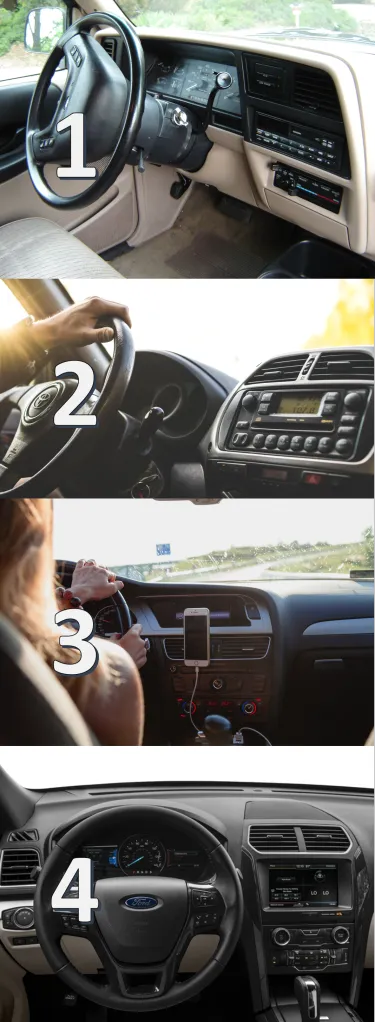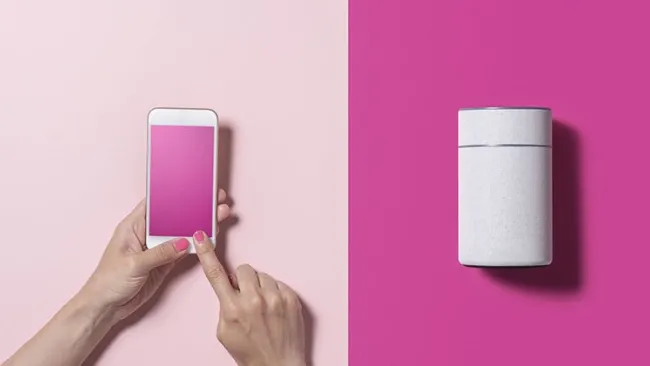Think for just a minute back to the vehicles you have driven throughout your life. How has the dashboard and basic features changed through the years?
The mid-1990s Ford Explorer that endured my early years of driving was exactly what you would expect from a typical mid-90s vehicle. There were heating/cooling options that were controlled by a sliding temperature gauge and a few knobs. Likely a limited number of programmable settings for the radio and a cassette player. When CDs became popular they quickly replaced the cassette players on dashboards. Possibly some temperature control or memory option modifications, but a similar look and feel with a modern twist.
I graduated from college, received my first non-internship job and was handed my first smartphone! It was time to get a new vehicle, not that totaling my college car had anything to do with it. This new-to-me vehicle still had the same CD player functionality but offered enhanced features on the radio, the ability to get satellite channels, and maybe a temperature control upgrade. But a life-changing feature was added: the ability to connect my smartphone.

Being able to marry the convenience of the smartphone with my vehicle, felt like a total game-changer. A few years later, my husband and I decided it was time; we needed a grown-up car. We were looking for a car that had the comfort and convenience we needed for our on-the-go lifestyle. We decided on a 2017 Ford Explorer. It has the contemporary features most present-day car shoppers look for and its sleek interface is essentially an extension of your smartphone as shown in image 4.
As you transition through the years, each of these dashboards serve essentially the same purpose, but fresh features and modern conveniences are continuously adapted into new iterations of these vehicles. The frequent innovations put into these automobiles, regardless of how small the upgrade over previous releases, is an easy way to envision modernization although the essential functionality hasn’t changed.
Following suit to the automobile industry, customer-facing technologies need to be recurrently updated to stay up-to-date and customer-friendly.
The daunting IVR menu
We have all called into a company and faced the daunting menu with endless pre recorded options to go through. The system behind these menu options is called an Interactive Voice Response (IVR). TechTarget exquisitely summarizes that an IVR is an automated telephony system that interacts with callers, gathers information and routes calls to the appropriate recipients. An IVR system (IVRS) accepts a combination of voice telephone input and touch-tone keypad selection and provides the appropriate responses in the form of voice, fax, callback, email and other contact methods.
There might be some anxiety rushing over you as you think about your last grueling IVR customer service experience and, sadly, you are not alone! This is not the technology’s fault rather how it was implemented. Your organization may have the following issues, or possibly you’ve experienced them yourself as a consumer:
- Menu options that loop customers in circles
- A head-spinning amount of menu choices
- Marketing messages that play before menu options are presented
- Outdated information/options cluttering the experience
This is trap that many organizations fall into because the team responsible for implementing contact center technologies was not concerned about the customer experience. Many customers, and even customer experience experts, might argue that an organization who cares about customers should get rid of the IVR customer service and allow a caller to connect straight to a human associate. I am going to agree with that argument partially, because a company should prioritize calls to lower waiting times for very important customers so they don't have to sit and wait. However, call queuing is the best method to connect your customers with the most knowledgeable associate to assist.
Is it time to spring clean your IVR to improve customer service?
Early IVR solutions were essentially pioneering self-service by automating customer interactions like providing customers with business hours, directions to a location or even checking on a customer’s balance. Today, a phone call is often the last resort of escalation for many customers, and these old best practices should be put to rest. If your IVR is advertising your website or sounds like a radio promotion, you’re wasting your customer’s time.
Most people who work with customer experience technologies recommend providing your customers with no more than four options per menu. That is the highest number of options you should ever provide, but shorter is always better. Brevity not only respects the customer’s time, but also encourages them to utilize the IVR menu options rather than pressing ‘0’ perpetually to bypass the menu altogether. Getting rid of IVR baggage, like dated prompts, respects customers’ time and can dramatically decrease your IVR abandon rate.
Modernizing your IVR technology allows you to give customers what they want
Convinced it’s time to give your IVR a little bit of attention? It doesn’t have to cost you an arm and a leg. While IVR customer service modernization can seem daunting, many of the new telephony systems on the market can be cheaper to implement than maintaining your old, outdated system. These modernized systems enable you to provide the personalization that customers want. Modernizing your IVR also allows you to give customers the self-service capabilities they expect, while offering loyal customers a predictable and context-aware experience when they call in. And as companies continue to implement more and more sophisticated contact center automation tools, it is essential that your organization stays ahead of the curve, or risk falling behind your competition.
Modernizing your IVR software gives you the opportunity to scrap all of the areas that make your call experience unfriendly. Customers are more educated and savvy than ever before and if your IVR isn’t geared towards that level of customer-awareness, it will seem monotonous and unhelpful. Easy IVRs get utilized by customers. IVRs are used to get your customers where they need to go, quickly. Quick routing speeds resolution and ultimately makes your customer happy. To learn more about the key features of a well designed IVR system, read our post Ten IVR Best Practices to Improve Customer Experiences.














